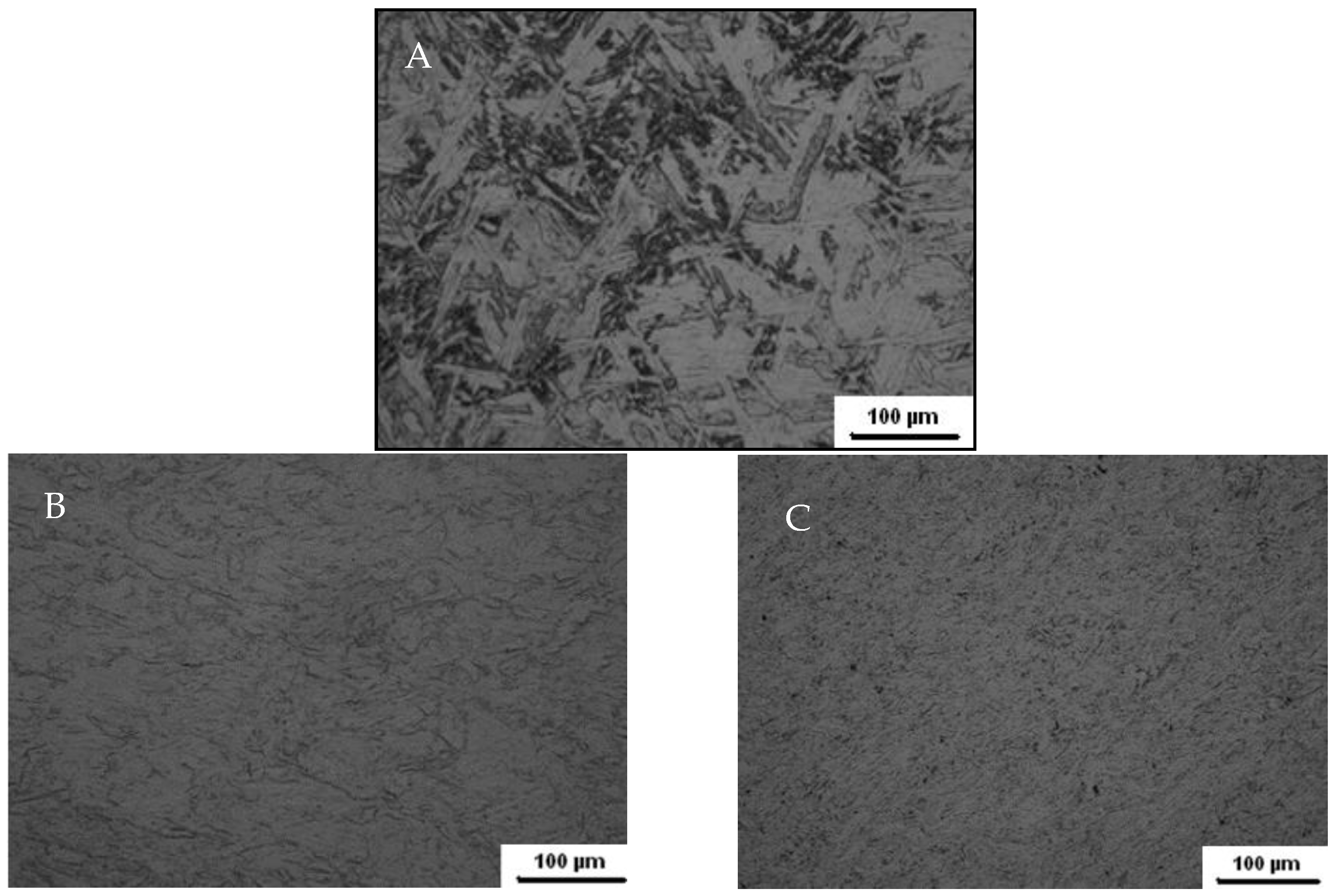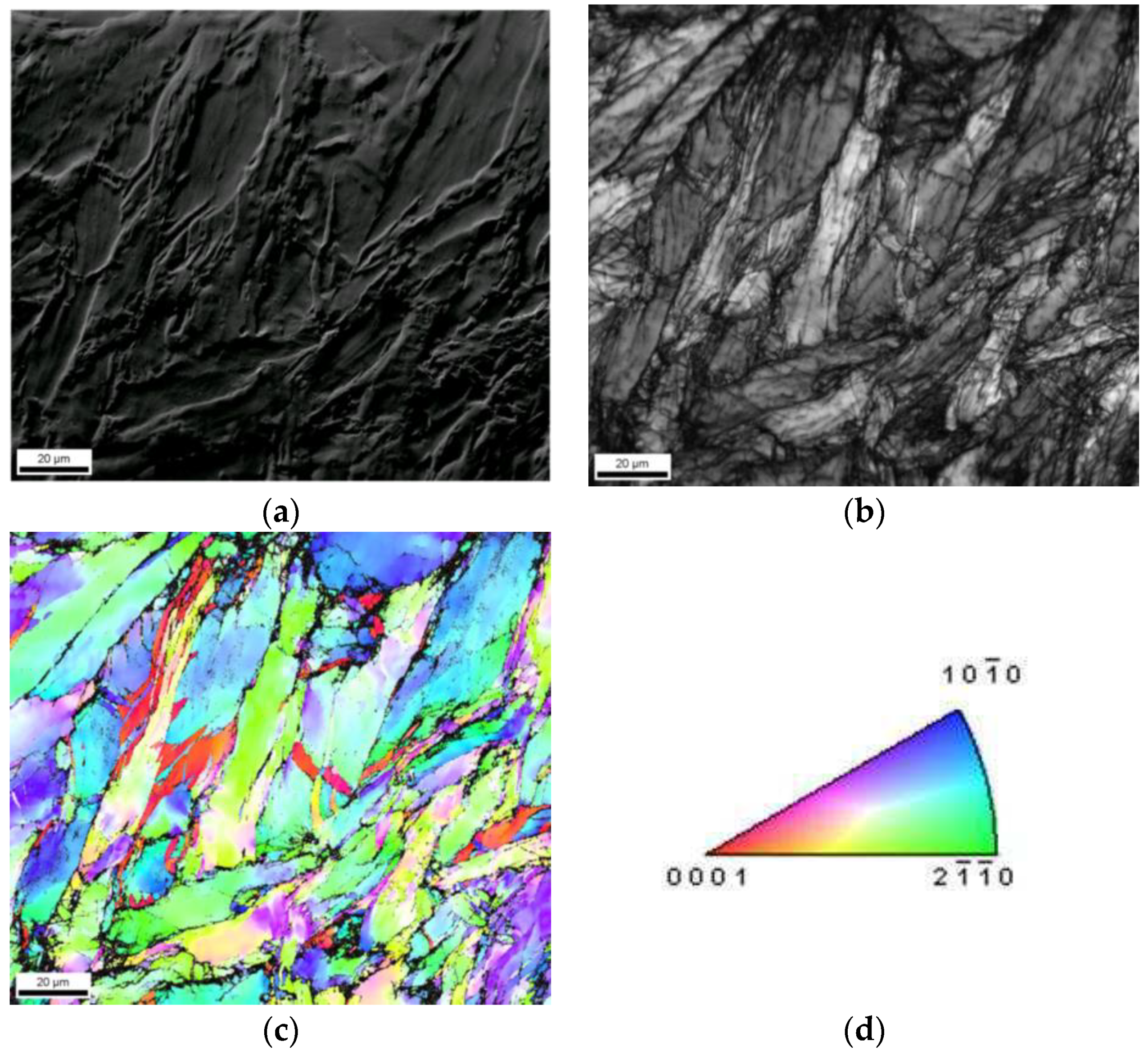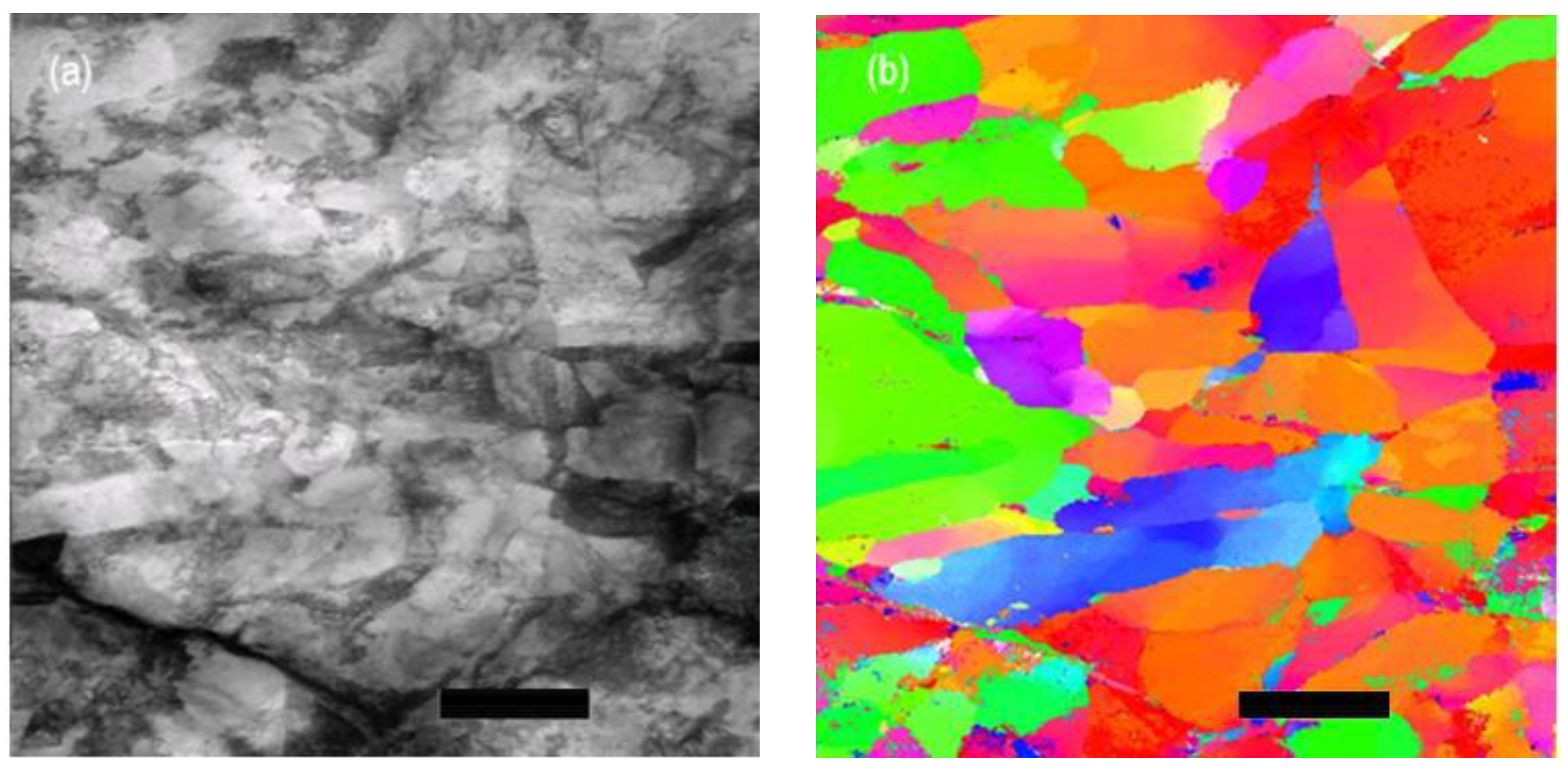ACOM/TEM and EBSD Microstructure Characterization of ECAE-Processed Zirconium
Abstract
1. Introduction
2. Materials and Methods
3. Results and Discussion
Light Microscopy
4. Conclusions
Author Contributions
Funding
Data Availability Statement
Acknowledgments
Conflicts of Interest
References
- Pokropivny, V.V.; Skorokhod, V.V. New Dimensionality Classifications of Nanostructures. Phys. E Low-Dimens. Syst. Nanostruct. 2008, 40, 2521–2525. [Google Scholar] [CrossRef]
- Valiev, R.Z.; Langdon, T.G. Principles of Equal-Channel Angular Pressing as a Processing Tool for Grain Refinement. Prog. Mater. Sci. 2006, 51, 881–981. [Google Scholar] [CrossRef]
- Meyers, M.A.; Mishra, A.; Benson, D.J. The Deformation Physics of Nanocrystalline Metals: Experiments, Analysis, and Computations. JOM 2006, 58, 41–48. [Google Scholar] [CrossRef]
- Wu, G.; Zaefferer, S. Advances in TEM Orientation Microscopy by Combination of Dark-Field Conical Scanning and Improved Image Matching. Ultramicroscopy 2009, 109, 1317–1325. [Google Scholar] [CrossRef] [PubMed]
- Moeck, P.; Rouvimov, S.; Rauch, E.F.; Nicolopoulos, S.; Secula, E.M.; Seiler, D.G.; Khosla, R.P.; Herr, D.; Michael Garner, C.; McDonald, R.; et al. Automated Crystal Phase and Orientation Mapping of Nanocrystals in a Transmission Electron Microscope. In Proceedings of the Frontiers of Characterization and Metrology for Nanoelectronics: 2009, Albany, NY, USA, 11–15 May 2009; AIP: Melville, NY, USA, 2009; pp. 304–308. [Google Scholar]
- Segal, V.M. Materials Processing by Simple Shear. Mater. Sci. Eng. A 1995, 197, 157–164. [Google Scholar] [CrossRef]
- Valiev, R.Z. Structure and Mechanical Properties of Ultrafine-Grained Metals. Mater. Sci. Eng. A 1997, 234–236, 59–66. [Google Scholar] [CrossRef]
- Saldana, L.; Mendezvilas, A.; Jiang, L.; Multigner, M.; Gonzalezcarrasco, J.; Perezprado, M.; Gonzalezmartin, M.; Munuera, L.; Vilaboa, N. In Vitro Biocompatibility of an Ultrafine Grained Zirconium. Biomaterials 2007, 28, 4343–4354. [Google Scholar] [CrossRef] [PubMed]
- Nathaniel, J.E.; Lang, A.C.; El-Atwani, O.; Suri, P.K.; Baldwin, J.K.; Kirk, M.A.; Wang, Y.; Taheri, M.L. Toward High-Throughput Defect Density Quantification: A Comparison of Techniques for Irradiated Samples. Ultramicroscopy 2019, 206, 112820. [Google Scholar] [CrossRef] [PubMed]
- Mu, X.; Kobler, A.; Wang, D.; Chakravadhanula, V.S.K.; Schlabach, S.; Szabó, D.V.; Norby, P.; Kübel, C. Comprehensive analysis of TEM methods for LiFePO4/FePO4 phase mapping: Spectroscopic techniques (EFTEM, STEM-EELS) and STEM diffraction techniques (ACOM-TEM). Ultramicroscopy 2016, 170, 10–18. [Google Scholar] [CrossRef]
- Dyakonov, G.S.; Mironov, S.; Semenova, I.P.; Valiev, R.Z.; Semiatin, S.L. Microstructure Evolution and Strengthening Mechanisms in Commercial-Purity Titanium Subjected to Equal-Channel Angular Pressing. Mater. Sci. Eng. A 2017, 701, 289–301. [Google Scholar] [CrossRef]
- Krywopusk, N.M.; Kecskes, L.J.; Weihs, T.P. Microstructural Characterization of Pure Mg and AZ31B Processed by ECAE. Mater. Charact. 2019, 158, 109950. [Google Scholar] [CrossRef]
- Proust, G.; Trimby, P.; Piazolo, S.; Retraint, D. Characterization of Ultra-Fine Grained and Nanocrystalline Materials Using Transmission Kikuchi Diffraction. JoVE 2017, 122, e55506. [Google Scholar] [CrossRef] [PubMed]
- Lee, B.S.; Kim, M.H.; Hwang, S.K.; Kwun, S.I.; Chae, S.W. Grain Refinement of Commercially Pure Zirconium by ECAP and Subsequent Intermediate Heat Treatment. Mater. Sci. Eng. A 2007, 449–451, 1087–1089. [Google Scholar] [CrossRef]
- Nikulin, S.A.; Rogachev, S.O.; Rozhnov, A.B.; Gorshenkov, M.V.; Kopylov, V.I.; Dobatkin, S.V. Resistance of Alloy Zr-2.5% Nb with Ultrafine-Grain Structure to Stress Corrosion Cracking. Met. Sci. Heat Treat. 2012, 54, 407–413. [Google Scholar] [CrossRef]
- Nikulin, S.A.; Rozhnov, A.B.; Rogachev, S.O.; Khatkevich, V.M.; Turchenko, V.A.; Khotulev, E.S. Investigation of Structure, Phase Composition, and Mechanical Properties of Zr-2.5% Nb Alloy after ECAP. Mater. Lett. 2016, 169, 223–226. [Google Scholar] [CrossRef]
- Sklenicka, V.; Dvorak, J.; Kral, P.; Svoboda, M.; Kvapilova, M.; Kopylov, V.I.; Nikulin, S.A.; Dobatkin, S.V. Creep Behavior of a Zirconium Alloy Processed by Equal-Channel Angular Pressing. Acta Phys. Pol. A 2012, 122, 485–489. [Google Scholar] [CrossRef]
- Sneddon, G.C.; Trimby, P.W.; Cairney, J.M. Transmission Kikuchi Diffraction in a Scanning Electron Microscope: A Review. Mater. Sci. Eng. R Rep. 2016, 110, 1–12. [Google Scholar] [CrossRef]
- Wu, X.; Zhu, Y. Heterogeneous materials: A new class of materials with unprecedented mechanical properties. Mater. Res. Lett. 2017, 5, 527–532. [Google Scholar] [CrossRef]








Disclaimer/Publisher’s Note: The statements, opinions and data contained in all publications are solely those of the individual author(s) and contributor(s) and not of MDPI and/or the editor(s). MDPI and/or the editor(s) disclaim responsibility for any injury to people or property resulting from any ideas, methods, instructions or products referred to in the content. |
© 2024 by the authors. Licensee MDPI, Basel, Switzerland. This article is an open access article distributed under the terms and conditions of the Creative Commons Attribution (CC BY) license (https://creativecommons.org/licenses/by/4.0/).
Share and Cite
Companhoni, M.V.P.; Gonçalves, A.-m.B.; Ferrante, M.; Sordi, V.; Pinto, A.L. ACOM/TEM and EBSD Microstructure Characterization of ECAE-Processed Zirconium. Metals 2024, 14, 624. https://doi.org/10.3390/met14060624
Companhoni MVP, Gonçalves A-mB, Ferrante M, Sordi V, Pinto AL. ACOM/TEM and EBSD Microstructure Characterization of ECAE-Processed Zirconium. Metals. 2024; 14(6):624. https://doi.org/10.3390/met14060624
Chicago/Turabian StyleCompanhoni, Mychelle Vianna Pereira, Além-mar Bernardes Gonçalves, Maurizio Ferrante, Vitor Sordi, and André Luiz Pinto. 2024. "ACOM/TEM and EBSD Microstructure Characterization of ECAE-Processed Zirconium" Metals 14, no. 6: 624. https://doi.org/10.3390/met14060624
APA StyleCompanhoni, M. V. P., Gonçalves, A.-m. B., Ferrante, M., Sordi, V., & Pinto, A. L. (2024). ACOM/TEM and EBSD Microstructure Characterization of ECAE-Processed Zirconium. Metals, 14(6), 624. https://doi.org/10.3390/met14060624





